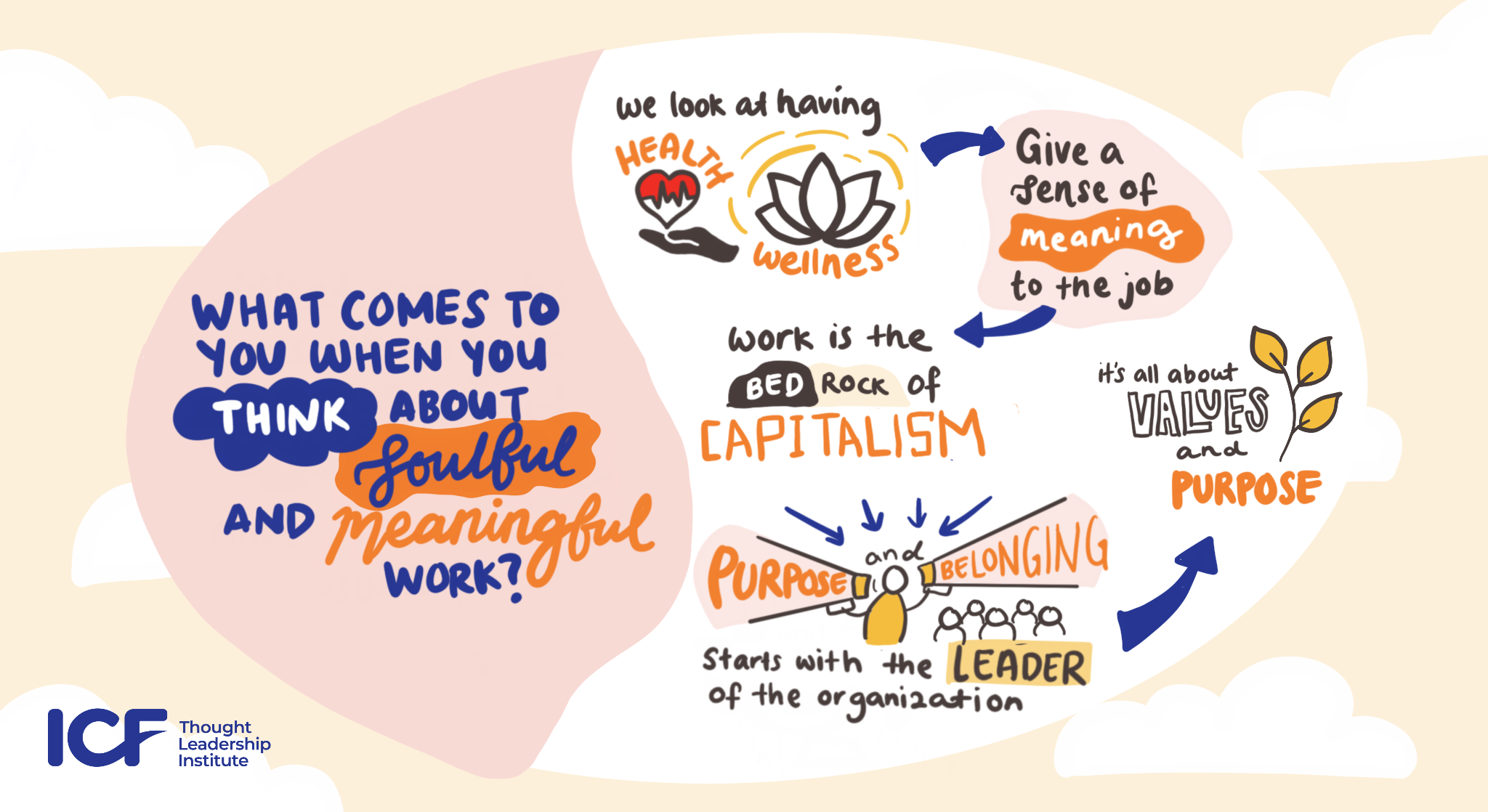Technological advances affect almost every aspect of work
Our Wisdom Weavers examined medical advances, new methods of personal development, and the biggest concern of all: equal access to technology.
Challenge:
The speed of technological innovation continues to accelerate.
Opportunity:
Digital transformation creates opportunities to re-design how people connect at work.
Impact:
Digital solutions can enhance well-being while improving work performance.
Wisdom Weavers
Technological change is an unavoidable aspect of modern life that will continuously redefine the world of work. For better or worse, the Covid-19 pandemic dramatically increased the ways in which people integrate technology into their work lives and their personal lives. Addressing how technology impacts human contact, the medical field, education, and more, the Wisdom Weavers from our 2021 Future of Work Convening offered thought-provoking perspectives on the so-called “new normal.” While their views are grounded in realistic concerns, they largely expressed cautious optimism about the benefits of technological advances to improve lives.
The evolution of technology in relation to the future of work intersects with The United Nations Global Goal #9 to build resilient infrastructure, promote inclusive and sustainable industrialization, and foster innovation. This goal specifically addresses the importance of increasing access to the latest technological applications. To combat inequality, increasing access to computers and the Internet for all people around the world must become a global priority.
With the recent acceleration of technological adoption, new opportunities and ways of thinking are coming to the fore
Connecting with colleagues and friends in different countries — or even continents — has become routine. Now that technology has simplified communication across geographic and political boundaries, a new desire is coming to the fore: the development of a universal language to improve collaboration and understanding among workers.
Wisdom Weaver Viviane Mansi pointed out that language often acts as a barrier to international communications. Although technology has connected workers separated by distance, she finds that language differences remain an impediment to understanding each other and being understood.
We have big challenges with language to make [universal dialogue] possible because, in a work-life like mine, just one percent of the population speak some kind of English … Technology will come in this way to permit us to [communicate] with everyone in one single language … probably we will encounter each other in a different way and the language will [no longer be] a barrier [in] maybe 10, 20 years.

Wisdom Weaver Dr. Stijn Broecke embraces the convenience of connecting with coworkers around the globe, a realization brought about in large part due to the accelerating adoption of technology during the pandemic.
It’s so much easier to reach out to people now and that’s something that before the pandemic never really crossed my mind that I could just set up a Zoom call with somebody in India. . . It [once seemed] to be a big thing to do that, whereas now it seems to be something normal. And maybe that normalization is something good that we take away [from the pandemic]. I hope we keep the good things and also remember the bad things so that we come out of this better than we were.

Wisdom Weaver Dr. Marcus Ranney drove home the point that these positive changes can be streamlined by looking at the well-being of employees and the way in which technology contributes to human flourishing.
I think the time is now right for us to tell the world that now we need to invest in the software of well-being…As companies think about the digital transformation they’re making, their employees’ lives, and connecting them digitally through communication and Zoom and computers, can we also tell them that it’s now time to invest in software that needs to be invested in their employees, which is around the well-being and the people?

The medical field is also benefiting from technological advances that improve surgical accuracy, awareness of human physiology, and access to care
Recent developments in robotics that improve operating room accuracy, along with the adoption of telemedicine and simplified communication, are improving the patient experience.
Marcus explained how technological advances in the medical field are helping doctors and patients gain a better understanding of why commonly accepted practices improve the body’s functioning.
The beauty of technology now is it’s providing us with the toolkit to actually analyze the suggestions that exist, and if you take something as simple as . . .intermittent fasting, something that I do in my life, now we’ve got the tools available to actually measure the biochemical changes in the body and what’s happening at the epigenetic level, at a mitochondrial level, and why fasting is good for you. And that’s what I find most fascinating is [that] technology is allowing us to catch up with wisdom and there’s so much that can be done.

Beyond medical technology advancements, access to care is becoming more flexible through telemedicine and online appointments — a practice that was once thought of as impractical.
If I would have told you five years ago that you would be doing many of your doctor’s visits virtually, you probably would have said, no, not me. That’s a very intimate conversation I have to have. But telemedicine, for example, and the way that it’s growing and the technology that’s enabling it and the opportunity to serve more people than you could imagine in a more efficient way.

New digital applications facilitate personal development
Individuals looking to strengthen their skills or even discover their personal strengths can use self-guided journeys to become the best versions of themselves.
Wisdom Weaver Dr. Dana Ardi shares entrepreneurial developments that help people set goals for personal improvement and track their progress through guided journeys.
I think [technology has worked] very well for coaches because we’re here to assist people on that journey of gaining the knowledge that they need, both personally and professionally. And it’s just really interesting because just recently I’ve interacted with several technology entrepreneurs who are developing technologies that people could go on their own guided journeys for their development to find ways to develop their skills.

Technology offers exciting new opportunities, but with every format, there are flaws and limitations
Wisdom Weavers William Ayot and Dr. Stijn Broecke speak from personal experience about the inherent limitations of technology to foster trust and strong connections.
William observed the limitations of technology-based communication in a workshop he led during lockdown.
What was really interesting is that by [meeting people] online . . . the level of trust was established very quickly because there was no sense of immediate personal space being invaded . . . But something else happened, and that was that we never really got to the truly authentic expressions of discomfort — of honest rage and anger of shame and envy — that you can get to [in person], which is what is so healing about them. So there was an immediate plus in the level of trust, but it didn’t actually happen, ultimately, and it did at a certain level, but not to the level that I would have been seeking.

Stijn furthers William’s concern about shallow connections formed online and laments the loss of rich relationship-building, which occurs in person.
In my job, I do a lot of Zoom meetings, and it is clearly not the same as having meetings in person, even if it’s just the cocktail after the conference, where you actually make the connections. On a personal level, these are the things that we miss out on in this digital world.

As communication through technology becomes the norm, access to computers and the Internet divides those who are engaged in the future of work from those who are left behind
Dana raises concerns about people who have been left behind during the pandemic due to lack of access to digital communication channels. She also addresses the effects of loneliness and isolation for people who have been unable to stay connected to friends and family during this long crisis.
There will be new industries, lots of them, and new opportunities. We just have to make sure that continuous learning and the opportunity to educate people to take advantage of these new opportunities. There’s still a lot of people [who] can’t play in the digital economy because they’re not computer literate. And how could you survive the last year if you didn’t know how to turn on a computer? Even if you weren’t working, just psychologically, if you couldn’t be connected using technology and there were lots of people that didn’t have that skill set.

The automations of work practices are reducing the amount of time needed to complete tasks
Historically speaking, employees are now working shorter weeks than previous generations. Although some have raised fears about robots taking jobs away from humans, The New York Times investigated the future of robots and what that means for jobs and found that robots are ineffective in the workplace without human support.
Stijn believes that the promise of automation is largely beneficial for humankind and holds the view that work in the future may be even less draining and stressful due to technological innovation.
[There] is a long-term trend that we are actually spending less time on work than we did 50 years ago and I think that’s a very positive trend. Even 100 years ago people spent even more time on work so that’s a positive trend, and I hope that trend continues through technology that we can, in a way, move towards this Keynesian utopia of less work, but also that, basically, we all have our own robot to do our own work so that reducing working time is equally distributed, now we can all benefit from technology and the progress that we may make so I think that that’s my utopian where I hope you will be the next 10-20 years, I doubt it, but it’s a dream.

Dana cautions that automation is reducing the number of jobs available. She calls for upskilling the workforce so that workers are not left behind.
I think we can alter the course of our own future of work by paying attention to some of the trends and listening to what people want and how they are processing all the changes that have gone on. I think technology will progress and progress and progress faster and more dramatically, and I think there’ll be fewer jobs. So what are we going to do? How are we going to help individuals find purpose and meaning at work? How are we going to find work for them to do? And if we don’t start to reskill and retool and think about our education system and all of the ecosystems that come together to build our future, then we really will be in trouble. . . [Technology] is an enabler, but it enables us to do away with things that traditionally were done with humans. So how are we going to teach humans other skills, other opportunities to find meaning?

Coaching Empowers People
Coaching aims to help individuals identify their strengths and apply their gifts in order to succeed in life and work. Technological innovation empowers coaches to reach a wider range of clients despite geographical distances. However, rapid developments in technology can leave people behind. The process of continuous learning and embracing change will become essential for positive adaptation in the future of work. Coaching can help people welcome change. The personalized nature of coaching is especially helpful for enabling people to embrace change and discover ways of keeping up with technology that work for them.




